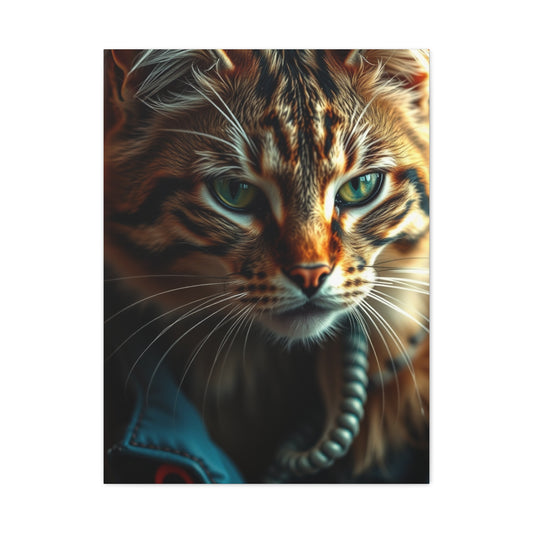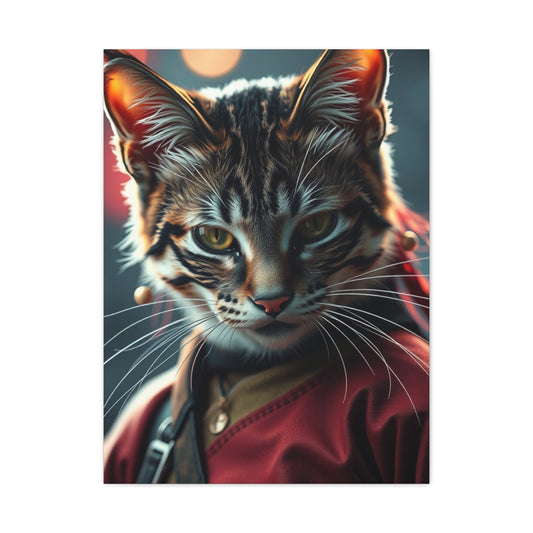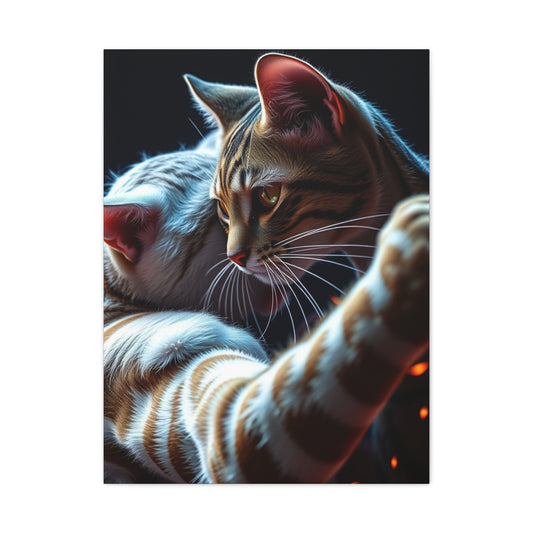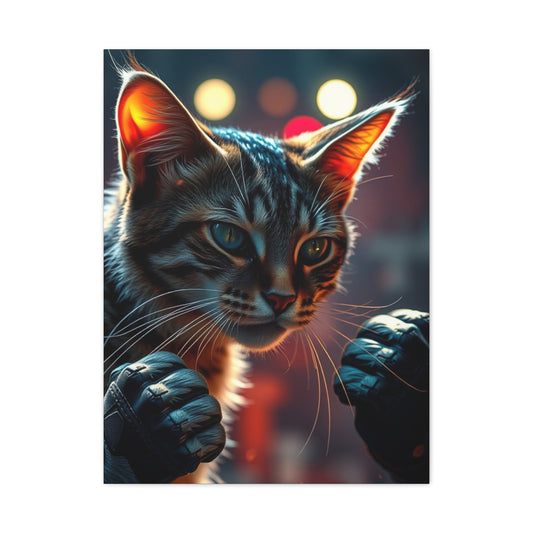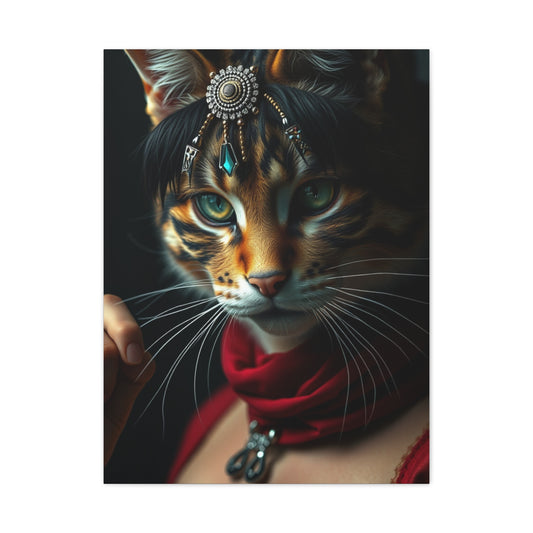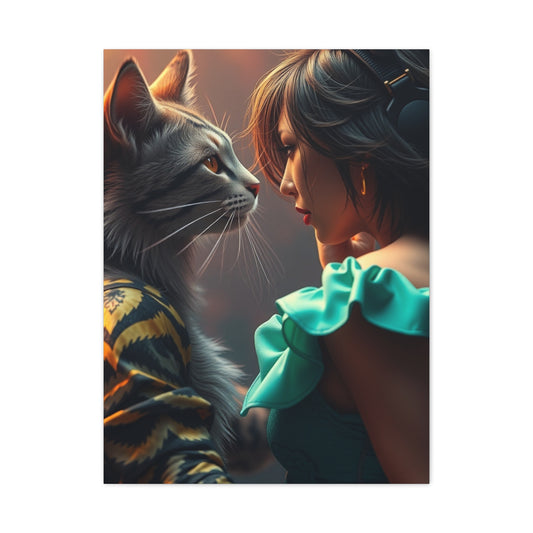The Power of Catfight Wall Art: Transforming Interiors with Contemporary Flair
The realm of contemporary interior design has witnessed an unprecedented surge in dynamic artwork that challenges conventional aesthetic boundaries. Among the most captivating and provocative art forms emerging in modern home décor is the fascinating world of catfight canvas art, where artistic expression meets raw emotional intensity. This comprehensive exploration delves into the multifaceted universe of bold catfight prints, examining their cultural significance, artistic merit, and transformative power in contemporary living spaces.
The conceptualization of catfight artwork transcends mere representation, evolving into a sophisticated artistic movement that captures the primal essence of feline confrontation through various interpretive lenses. Modern artists have embraced this theme not merely for its dramatic visual impact, but for its profound symbolic representation of conflict, territoriality, and the untamed aspects of natural behavior. These artistic interpretations range from hyperrealistic depictions that showcase every whisker and claw in meticulous detail to abstract representations that distill the essence of feline aggression into swirling patterns of color and movement.
Contemporary catfight canvas art serves as a powerful metaphor for human struggles, territorial disputes, and the inherent wildness that exists beneath civilized facades. Artists working within this genre often employ sophisticated techniques that blend traditional painting methods with digital enhancement, creating layered compositions that reveal new details upon closer examination. The interplay between light and shadow, the careful attention to muscular tension, and the electric energy captured in mid-motion all contribute to creating pieces that are both visually arresting and emotionally resonant.
The artistic merit of these works extends beyond their immediate visual impact, incorporating elements of behavioral psychology, animal studies, and cultural anthropology. Many pieces feature subtle environmental details that contextualize the conflict, whether set against urban landscapes, natural wilderness, or abstract dimensional spaces that exist purely within the artist's imagination. This contextual framework adds layers of meaning that invite viewers to contemplate broader themes of survival, competition, and the complex relationships between civilization and wildness.
Aesthetic Dimensions of Bold Catfight Prints
The technical execution of bold catfight prints requires extraordinary skill in capturing motion, emotion, and anatomical precision simultaneously. Master artists specializing in this genre have developed innovative techniques for rendering fur texture, capturing the luminosity of eyes in combat, and depicting the kinetic energy of bodies in motion. The color palettes employed range from naturalistic earth tones that emphasize realism to vibrant, electric hues that amplify the emotional intensity of the confrontation.
Advanced printing technologies have revolutionized how these artistic visions translate from canvas to various media formats. High-resolution digital printing allows for incredible detail retention, ensuring that every brushstroke, every subtle gradation of color, and every textural element is preserved in the final print. This technological advancement has democratized access to museum-quality artwork, making it possible for art enthusiasts to acquire pieces that rival original paintings in their visual impact and aesthetic appeal.
The compositional strategies employed in bold catfight prints often utilize dynamic diagonal lines, dramatic perspective shifts, and strategic use of negative space to create compositions that seem to burst beyond the confines of their frames. Artists frequently employ techniques borrowed from comic book illustration, cinematic storytelling, and classical battle paintings to create narratives that unfold across the canvas surface. These compositional choices contribute to the overall dramatic impact while maintaining artistic sophistication that appeals to serious collectors and casual admirers alike.
Modern Catfight Wall Décor Integration Strategies
Incorporating modern catfight wall décor into contemporary living spaces requires careful consideration of scale, placement, and thematic coherence with existing design elements. These powerful artworks function best as focal points within a room, commanding attention while complementing rather than overwhelming the surrounding aesthetic environment. Interior designers increasingly recognize the transformative potential of dramatic animal-themed artwork in creating spaces that feel both sophisticated and emotionally engaging.
The psychological impact of displaying catfight artwork extends beyond mere aesthetic appreciation, tapping into primal responses to conflict, movement, and natural beauty. Research in environmental psychology suggests that dynamic artwork featuring animal subjects can increase feelings of vitality, connection to nature, and emotional engagement within living spaces. This psychological dimension makes catfight wall décor particularly effective in spaces designed for social interaction, creative work, or personal reflection.
Strategic lighting considerations play a crucial role in maximizing the impact of modern catfight wall décor. Directional lighting can emphasize textural elements, enhance color vibrancy, and create dramatic shadow effects that amplify the artwork's inherent dynamism. Many collectors invest in specialized art lighting systems that can be adjusted throughout the day to showcase different aspects of their catfight artwork, creating an ever-evolving visual experience that maintains its capacity to surprise and delight.
Artistic Catfight Designs:
The evolution of artistic catfight designs reflects broader trends in contemporary art, incorporating elements from street art, pop culture, digital art, and traditional fine art traditions. This stylistic diversity ensures that catfight artwork can complement a wide range of interior design aesthetics, from minimalist modern spaces to eclectic bohemian environments. Artists working within this genre continuously push creative boundaries, experimenting with mixed media approaches, unconventional materials, and innovative presentation formats.
Neo-expressionist influences appear frequently in contemporary catfight designs, with artists employing bold brushstrokes, exaggerated proportions, and emotionally charged color palettes to intensify the dramatic impact of their subjects. This approach creates artwork that feels immediate and visceral while maintaining sophisticated artistic craftsmanship. The tension between raw emotional expression and technical precision creates compelling visual experiences that reward both casual viewing and detailed study.
Photorealistic approaches to catfight artwork have gained prominence as digital art tools have become more sophisticated and accessible. These hyperdetailed works often blur the line between photography and painting, creating images of such precision and clarity that viewers must examine them closely to determine their medium. This photorealistic trend has opened new possibilities for artistic expression while challenging traditional boundaries between different art forms.
Catfight Abstract Art:
The realm of catfight abstract art pushes artistic interpretation beyond literal representation, exploring the emotional, psychological, and energetic dimensions of feline conflict through non-representational means. Abstract artists working within this theme often focus on capturing the essence of movement, the rhythm of combat, and the emotional intensity of confrontation through color relationships, gestural marks, and compositional dynamics rather than recognizable imagery.
Color theory plays a particularly important role in catfight abstract art, with artists employing contrasting hues to represent opposing forces, warm tones to convey aggression and energy, and cool tones to suggest calculation and stealth. The interplay between these color relationships creates visual tension that mirrors the psychological tension of the subject matter. Advanced color mixing techniques allow artists to create subtle gradations and unexpected color harmonies that add complexity and depth to apparently simple compositions.
Gestural abstraction within catfight artwork often incorporates calligraphic elements that suggest movement, scratching motions, and the fluid dynamics of bodies in combat. These gestural marks serve as visual metaphors for the physical actions they represent while maintaining independence as abstract artistic elements. The resulting artworks function on multiple interpretive levels, appealing to viewers who appreciate pure abstract composition as well as those who find meaning in the representational associations.
Unique Catfight Wall Style:
Developing a unique catfight wall style requires understanding both the artistic traditions within this genre and the specific aesthetic preferences of individual collectors. The most successful approaches to catfight wall décor involve curating collections that reflect personal taste while demonstrating appreciation for artistic quality and thematic coherence. This process often involves acquiring pieces from multiple artists working in different styles while maintaining visual consistency through careful attention to color palettes, scale relationships, and thematic connections.
Eclectic approaches to catfight wall styling might combine realistic paintings with abstract interpretations, photography with digital art, and traditional media with contemporary mixed-media approaches. The key to successful eclectic styling lies in identifying unifying elements that create coherence despite stylistic diversity. These unifying elements might include consistent color schemes, similar emotional tones, comparable scales, or shared thematic concerns that transcend specific artistic approaches.
Minimalist approaches to unique catfight wall style focus on selecting fewer pieces of exceptional quality and presenting them in ways that maximize their individual impact. This approach requires careful attention to spacing, lighting, and surrounding design elements to ensure that each piece receives appropriate attention while contributing to an overall aesthetic vision. Minimalist catfight wall styling often emphasizes the sculptural qualities of artwork, treating each piece as a three-dimensional object that interacts with its spatial environment.
Catfight Pop Art Prints:
The intersection of catfight imagery with pop art sensibilities creates fascinating opportunities for cultural commentary and artistic innovation. Pop art approaches to catfight themes often incorporate elements from advertising, mass media, and consumer culture to create works that function simultaneously as entertainment and critique. These pieces might reference comic book aesthetics, employ bold graphic design elements, or incorporate textual components that add layers of meaning to the visual content.
Contemporary catfight pop art prints frequently address themes of gender dynamics, power relationships, and social competition through the metaphorical lens of feline conflict. Artists working within this tradition often employ irony, humor, and cultural references to create works that engage with serious social issues while remaining visually accessible and entertaining. This balance between entertainment and social commentary reflects the broader traditions of pop art while addressing contemporary concerns and perspectives.
Digital manipulation techniques have expanded the possibilities for catfight pop art, allowing artists to incorporate photographic elements, manipulate scale relationships, and create surreal juxtapositions that would be impossible through traditional artistic means. These digital approaches often result in works that feel simultaneously familiar and alien, combining recognizable imagery with unexpected contexts and transformations that challenge viewers' assumptions and expectations.
Expressive Catfight Artwork:
The psychological dimensions of expressive catfight artwork extend far beyond mere visual entertainment, tapping into deep-seated emotional responses to conflict, territoriality, and natural behavior. These works often serve as outlets for viewers' own experiences with competition, aggression, and the complex dynamics of interpersonal relationships. The metaphorical power of feline conflict provides a safe framework for exploring difficult emotions and psychological states that might be challenging to address directly.
Therapeutic applications of expressive catfight artwork have gained recognition within art therapy and environmental psychology communities. The dynamic nature of these images can stimulate emotional processing, encourage self-reflection, and provide focal points for meditation and contemplation. Many collectors report that living with expressive catfight artwork helps them process their own experiences with conflict while appreciating the beauty inherent in natural behavior patterns.
The technical execution of expressive catfight artwork often emphasizes gestural qualities, bold mark-making, and emotionally charged color palettes that convey intensity and movement. Artists working within this tradition frequently employ techniques borrowed from abstract expressionism, action painting, and gestural drawing to create works that feel immediate and emotionally authentic. The resulting pieces often retain visible evidence of their creation process, allowing viewers to connect with the artist's emotional and physical engagement with the subject matter.
Catfight Contemporary Décor:
The integration of catfight contemporary décor within modern living environments requires sophisticated understanding of spatial relationships, color coordination, and thematic appropriateness. These powerful artworks function most effectively when they enhance rather than dominate their surroundings, creating focal points that draw attention while harmonizing with existing design elements. Professional interior designers increasingly recognize the potential of dramatic animal-themed artwork to transform spaces and create memorable environments.
Scale considerations play a crucial role in successful catfight contemporary décor implementation. Large-scale pieces can anchor entire rooms, creating dramatic focal points that influence traffic patterns and social interactions within the space. Medium-scale works often function best in groupings, allowing for visual dialogue between pieces while maintaining individual impact. Small-scale catfight artwork can serve as accent pieces, adding visual interest to intimate spaces or complementing larger artistic installations.
Color coordination between catfight artwork and surrounding décor elements requires careful attention to both dominant and accent colors within each piece. Many successful installations employ neutral backgrounds that allow artwork colors to dominate while providing subtle harmonies through carefully selected accessories, textiles, and furniture finishes. This approach ensures that the artwork remains the primary visual focus while feeling integrated rather than imposed upon the space.
Dramatic Catfight Wall Art:
The creation of truly dramatic catfight wall art requires masterful control of visual elements that contribute to emotional impact and psychological engagement. These elements include strategic use of contrast, dynamic compositional structures, and carefully orchestrated color relationships that work together to create artworks that command attention and reward extended viewing. The most successful dramatic pieces often incorporate multiple layers of visual interest that reveal themselves gradually as viewers spend time with the work.
Lighting design plays a particularly crucial role in maximizing the dramatic impact of catfight wall art. Professional lighting systems can emphasize textural qualities, enhance color saturation, and create shadow effects that add dimensionality and mystery to flat artworks. Many collectors invest in programmable lighting systems that can be adjusted throughout the day to showcase different aspects of their dramatic catfight artwork, creating dynamic visual experiences that evolve with changing light conditions.
The psychological impact of dramatic catfight wall art extends beyond immediate visual pleasure, often serving as conversation starters, meditation focal points, and sources of ongoing visual discovery. These works often incorporate subtle details that become apparent only through repeated viewing, ensuring that they continue to offer new experiences and insights over time. This quality of sustained interest makes dramatic catfight artwork particularly valuable as long-term investments in environmental quality and personal satisfaction.
Stylish Catfight Canvas: Sophisticated Approaches to Animal-Themed Art
The development of stylish catfight canvas art represents the sophisticated evolution of animal-themed artwork from purely decorative objects to serious artistic statements that can enhance the most refined interior environments. This evolution reflects broader trends in contemporary art collecting, where subject matter diversity has become less important than artistic quality, conceptual depth, and aesthetic sophistication. Modern catfight canvas art often incorporates elements from fine art traditions while maintaining accessibility and emotional immediacy.
Technical innovations in canvas preparation, paint application, and surface treatment have enabled artists to create catfight artwork with unprecedented levels of detail, color accuracy, and longevity. Museum-quality materials and archival processes ensure that these works can provide decades of viewing pleasure while maintaining their original visual impact. These technical advances have elevated catfight canvas art from novelty items to legitimate collectibles that can appreciate in value over time.
The curation of stylish catfight canvas collections requires understanding both artistic merit and personal aesthetic preferences. Successful collectors often develop relationships with specific artists whose work resonates with their sensibilities, building collections that reflect both individual taste and artistic quality. This approach ensures that collections maintain coherence while providing opportunities for growth and refinement over time.
Catfight Creative Prints: Innovation in Artistic Expression and Production
The realm of catfight creative prints encompasses a vast spectrum of artistic approaches, production techniques, and presentation formats that push the boundaries of traditional printmaking while maintaining connection to established artistic traditions. Contemporary print artists working within this genre often combine traditional techniques such as lithography, etching, and screen printing with digital processes to create works that would be impossible through any single medium. This hybrid approach allows for unprecedented creative flexibility while maintaining the tactile qualities and visual richness that make prints particularly appealing to collectors.
Experimental approaches to catfight creative prints often incorporate unconventional materials, unusual scales, and innovative presentation formats that challenge viewers' expectations about what constitutes a print. Some artists embed textural elements within their prints, creating works that invite both visual and tactile engagement. Others experiment with transparent substrates, metallic inks, or glow-in-the-dark elements that create different visual experiences under varying lighting conditions.
The democratizing aspect of print production makes catfight creative prints accessible to a broader audience than unique paintings or sculptures, while limited edition numbering maintains collectibility and exclusivity. This accessibility has contributed to growing interest in print collecting and has encouraged artists to invest greater creative energy in printmaking as a legitimate artistic medium rather than merely a reproduction technique.
Iconic Catfight Wall Décor: Establishing Visual Landmarks in Interior Design
The concept of iconic catfight wall décor refers to artworks that transcend mere decoration to become defining elements of interior spaces, creating memorable visual experiences that influence how occupants and visitors perceive and interact with the environment. These iconic pieces often combine exceptional artistic quality with strategic placement and presentation to create lasting impressions that enhance the overall character and sophistication of living spaces.
Achieving iconic status for catfight wall décor requires careful consideration of multiple factors including artistic merit, historical significance, cultural relevance, and personal meaning. The most successful iconic pieces often tell stories that extend beyond their immediate visual content, incorporating cultural references, artistic innovations, or personal significance that adds depth and complexity to the viewing experience. These narrative dimensions ensure that the artwork continues to engage viewers over extended periods rather than losing impact through familiarity.
The investment potential of iconic catfight wall décor has attracted attention from serious art collectors who recognize the growing cultural acceptance and artistic sophistication within this genre. Early works by established artists often appreciate significantly in value as their reputations grow and demand increases. This investment potential, combined with immediate aesthetic pleasure, makes iconic catfight wall décor particularly attractive to collectors who want artworks that provide both emotional satisfaction and financial security.
Catfight Urban Art:
The intersection of catfight themes with urban art traditions creates fascinating opportunities for cultural commentary and artistic innovation. Urban artists often bring different perspectives and techniques to catfight imagery, incorporating elements from graffiti, street art, and hip-hop culture to create works that feel both contemporary and connected to broader cultural movements. These urban influences often result in artworks that are more accessible and culturally relevant than traditional fine art approaches.
Catfight urban art frequently addresses themes of territory, competition, and survival that resonate strongly with urban experiences and contemporary social dynamics. Artists working within this tradition often employ bold graphics, spray paint techniques, and stencil work to create pieces that maintain the immediacy and impact of street art while functioning effectively within gallery and home environments. This translation between street and interior contexts requires sophisticated understanding of scale, context, and audience expectations.
The cultural authenticity of catfight urban art often depends on artists' genuine connections to urban communities and street art traditions rather than superficial adoption of urban aesthetics. The most successful works within this category demonstrate deep understanding of urban culture while contributing original perspectives and artistic innovations. This authenticity ensures that the artwork feels genuine rather than contrived, contributing to its long-term cultural relevance and artistic value.
Trendy Catfight Wall Style:
The identification and adoption of trendy catfight wall style requires staying current with broader movements in contemporary art, interior design, and cultural expression while maintaining personal aesthetic integrity. Current trends within this category include increased emphasis on environmental themes, incorporation of digital and mixed-media techniques, and growing interest in works that address social and political issues through metaphorical frameworks.
Social media influence on trendy catfight wall style has created new opportunities for artists to gain recognition while also creating pressure to produce work that photographs well and generates online engagement. This digital dimension has influenced both artistic creation and collection practices, with many collectors now considering how artwork will appear in social media posts alongside its immediate visual impact in their living spaces.
The globalization of art markets has introduced international perspectives and techniques to catfight wall style trends, creating opportunities for cross-cultural dialogue and artistic exchange. Artists from different cultural backgrounds bring unique perspectives to catfight themes, often incorporating traditional techniques, cultural symbols, and alternative narrative frameworks that enrich the overall diversity and sophistication of the genre.
Color Theory and Visual Psychology in Catfight Artwork
The application of advanced color theory principles in catfight artwork involves sophisticated understanding of how different hues, saturations, and value relationships contribute to emotional impact and visual engagement. Warm colors such as reds, oranges, and yellows are frequently employed to convey aggression, energy, and emotional intensity, while cool colors like blues and purples often represent calculation, stealth, and emotional distance. The strategic juxtaposition of warm and cool colors can create visual tension that mirrors the psychological tension of the subject matter.
Color psychology research indicates that certain color combinations can trigger specific emotional responses and physiological reactions in viewers. Many catfight artists consciously employ these principles to enhance the emotional impact of their work, using color relationships to guide viewer attention, create mood, and reinforce thematic content. Understanding these psychological dimensions allows both artists and collectors to make more informed choices about color palettes and their potential effects within specific environments.
The technical execution of sophisticated color relationships requires mastery of color mixing, layering techniques, and understanding of how colors interact under different lighting conditions. Professional catfight artists often invest years in developing their color skills, studying the work of master colorists and experimenting with different pigments and application techniques. This technical foundation enables them to create works with exceptional color richness and emotional resonance.
Compositional Strategies and Visual Dynamics
The compositional structure of effective catfight artwork requires careful balance between dynamic action and visual stability, creating images that convey movement and energy while maintaining compositional integrity. Traditional compositional principles such as the rule of thirds, dynamic symmetry, and golden ratio proportions provide frameworks for organizing complex scenes involving multiple figures, environmental elements, and dramatic action sequences.
Movement representation in catfight artwork often employs techniques borrowed from comic book illustration, including motion lines, strategic blurring, and sequential imagery that suggests temporal progression. These techniques allow static images to convey the kinetic energy and temporal complexity of actual feline conflicts while maintaining visual clarity and artistic sophistication. The most successful works often balance realistic representation with stylized elements that enhance dramatic impact.
Depth creation through atmospheric perspective, overlapping forms, and strategic use of detail variation helps establish spatial relationships that make catfight scenes feel three-dimensional and immersive. Advanced artists often employ multiple perspective systems within single compositions, creating complex spatial environments that reward careful examination while maintaining immediate visual impact for casual viewers.
Material Innovation and Technical Excellence
Contemporary catfight artists increasingly experiment with unconventional materials and techniques that expand expressive possibilities while maintaining connection to traditional artistic methods. Mixed-media approaches might combine traditional oil painting with collage elements, digital printing, or sculptural components that add textural and dimensional interest to otherwise flat artworks. These material innovations often reflect thematic concerns about wildness, civilization, and the boundaries between natural and artificial environments.
Archival quality considerations have become increasingly important as catfight artwork gains recognition as serious collectible art. Professional artists now routinely employ museum-quality materials and conservation techniques that ensure their works can provide decades of viewing pleasure while maintaining original color accuracy and structural integrity. These technical standards have elevated catfight artwork from novelty items to legitimate artistic investments.
Surface preparation techniques for catfight canvas art often involve multiple layers of primer, specialized texture treatments, and careful attention to substrate selection that enhances the specific requirements of each artistic approach. Oil painters might require different surface preparations than acrylic artists, while mixed-media works often demand specialized primers that can accommodate diverse material combinations without compromising adhesion or longevity.
Cultural Context and Artistic Legitimacy
The growing cultural acceptance of catfight artwork reflects broader changes in contemporary art appreciation, where subject matter diversity has become less important than artistic quality, conceptual depth, and emotional authenticity. This evolution has enabled catfight artists to gain recognition within mainstream art communities while maintaining their distinctive thematic focus and creative approaches.
Academic study of animal behavior and psychology has provided scientific foundations that legitimize artistic exploration of feline conflict themes. Research into territorial behavior, social dominance, and survival strategies offers conceptual frameworks that artists can employ to create works with intellectual depth alongside emotional impact. This scientific grounding helps distinguish serious catfight artwork from purely sensational or exploitative approaches to the subject matter.
Museum and gallery representation of catfight artwork has increased significantly as institutions recognize the artistic merit and cultural relevance of well-executed pieces within this genre. Major exhibitions featuring animal-themed contemporary art increasingly include catfight works alongside other wildlife and domestic animal subjects, confirming their legitimacy within serious artistic discourse.
Market Dynamics and Collecting Strategies
The catfight artwork market has developed increasing sophistication as collectors recognize the investment potential and aesthetic value of high-quality pieces within this genre. Primary market sales through galleries and artist studios provide opportunities to acquire works directly from creators, often at prices that reflect artistic merit rather than speculative value. Secondary market activity indicates growing collector interest and price appreciation for established artists.
Collecting strategies for catfight artwork might focus on specific artistic styles, particular artists whose work demonstrates consistent quality and innovation, or thematic approaches that create coherent collection narratives. Successful collectors often develop expertise within their chosen focus areas, enabling them to identify exceptional works and anticipate market trends. This expertise development requires ongoing education, gallery visits, and engagement with artist communities.
Authentication and provenance documentation have become increasingly important as catfight artwork values appreciate and institutional interest grows. Professional collectors routinely request certificates of authenticity, maintain detailed acquisition records, and ensure proper insurance coverage for valuable pieces. These practices protect investments while contributing to market stability and artistic legitimacy.
Digital Integration and Contemporary Presentation
Digital technology integration within catfight artwork creation and presentation has opened new possibilities for artistic expression while raising questions about traditional art categories and market valuations. Digital painting tools enable artists to achieve effects that would be impossible through traditional media, while digital printing technologies allow for reproduction quality that rivals original paintings in visual impact and longevity.
Virtual reality and augmented reality applications are beginning to influence how catfight artwork is experienced and collected. Some artists now create works specifically designed for digital environments, while others develop companion digital experiences that enhance traditional artworks through interactive elements or additional contextual information. These technological integrations suggest future directions for artistic development and audience engagement.
Social media platforms have become crucial tools for catfight artists to build audiences, sell work, and participate in broader cultural conversations about art and creativity. The visual nature of social media particularly suits catfight artwork, which often photographs well and generates strong emotional responses that translate effectively to digital sharing. This online presence has democratized access to art markets while creating new challenges around copyright protection and image quality control.
Environmental Considerations and Sustainable Practices
Sustainability concerns within catfight artwork production reflect broader environmental consciousness in contemporary art communities. Artists increasingly consider the environmental impact of their material choices, studio practices, and shipping requirements while maintaining artistic quality and creative freedom. These considerations often lead to innovations in sustainable art materials and production techniques.
Local sourcing of materials and services supports community economies while reducing transportation-related environmental impacts. Many catfight artists now prioritize relationships with local suppliers, framers, and galleries, creating sustainable business models that benefit both artistic careers and community development. This localized approach often results in distinctive regional styles that reflect particular geographic and cultural influences.
Longevity considerations in material selection contribute to sustainability by creating artworks that can provide decades of viewing pleasure without requiring replacement or significant conservation intervention. Artists who prioritize archival quality materials and proven techniques create works that represent more sustainable investments than pieces requiring frequent maintenance or early replacement due to material failure.
Educational Value and Cultural Transmission
The educational potential of catfight artwork extends beyond aesthetic appreciation to include lessons about animal behavior, artistic technique, cultural values, and creative expression. Many collectors use their artwork as starting points for discussions about nature, competition, artistic process, and cultural diversity with family members, friends, and visitors. This educational dimension adds value that extends beyond immediate visual pleasure.
Children's responses to catfight artwork often demonstrate natural curiosity about animal behavior and artistic representation that can be channeled into educational opportunities. Age-appropriate discussions about the artistic process, animal behavior, and cultural meanings can help develop aesthetic appreciation and critical thinking skills while respecting family values and cultural sensitivities.
Academic research into catfight artwork and related cultural phenomena contributes to broader understanding of contemporary art movements, animal representation in visual culture, and the intersection between popular culture and fine art. This scholarly attention legitimizes the genre while providing frameworks for understanding its cultural significance and artistic development.
Psychological Benefits
The therapeutic potential of catfight artwork extends beyond mere aesthetic pleasure to encompass stress relief, emotional processing, and environmental enhancement that contributes to psychological wellbeing. The dynamic nature of these images can provide visual stimulation that counters monotony while offering safe frameworks for exploring complex emotions related to conflict, territory, and natural behavior.
Art therapy applications of catfight imagery often focus on the metaphorical dimensions of conflict and resolution, allowing individuals to explore personal challenges through projected identification with animal subjects. The removal from direct human representation can make difficult topics more approachable while maintaining emotional authenticity and therapeutic value. Professional art therapists increasingly recognize the potential of animal-themed artwork in therapeutic contexts.
Meditation and mindfulness practices often benefit from focal objects that provide visual interest without overwhelming complexity. Well-chosen catfight artwork can serve this function, offering sufficient detail and emotional content to maintain attention while supporting contemplative states and stress reduction. The natural themes often present in this artwork can enhance connection to non-urban environments and natural rhythms.
Conclusion
The multifaceted world of catfight canvas art represents a remarkable convergence of artistic excellence, cultural significance, and contemporary relevance that has elevated this genre from novelty entertainment to serious artistic discourse. Throughout this comprehensive exploration, we have examined the diverse dimensions that contribute to the enduring appeal and growing sophistication of catfight artwork, from technical mastery and aesthetic innovation to psychological impact and cultural meaning.
The artistic merit of contemporary catfight artwork cannot be understated, as evidenced by the exceptional technical skill required to capture the dynamic movement, emotional intensity, and anatomical precision that define the most compelling pieces within this genre. Artists working in this field have demonstrated remarkable innovation in combining traditional techniques with contemporary approaches, creating works that honor artistic tradition while pushing creative boundaries. The resulting pieces often achieve levels of sophistication that rival any contemporary art form, proving that subject matter alone does not determine artistic value.
The cultural evolution of catfight artwork reflects broader changes in contemporary art appreciation, where diversity of subject matter has become less important than artistic quality, conceptual depth, and emotional authenticity. This transformation has enabled talented artists to gain recognition within mainstream art communities while maintaining their distinctive thematic focus and creative vision. The growing institutional acceptance, including museum exhibitions and gallery representation, confirms the legitimate place of high-quality catfight artwork within serious artistic discourse.
From a psychological perspective, the enduring appeal of catfight artwork stems from its ability to tap into fundamental human responses to conflict, territoriality, and natural behavior. These works provide safe frameworks for exploring complex emotions and psychological states while offering aesthetic pleasure and intellectual engagement. The therapeutic applications of catfight artwork, from stress relief to art therapy contexts, demonstrate the profound impact that thoughtfully created visual art can have on human wellbeing and emotional processing.
The technical innovations that continue to emerge within catfight artwork production reflect the dedication of artists to achieving ever-higher levels of quality and expressive possibility. From advanced color theory applications to experimental material combinations, from digital integration to sustainable production practices, artists within this genre consistently demonstrate commitment to excellence and innovation. These technical advances ensure that catfight artwork will continue to evolve and improve while maintaining connection to established artistic traditions.
The market dynamics surrounding catfight artwork collection reveal growing sophistication among both artists and collectors, with increasing attention to investment potential, authentication procedures, and market development. This economic dimension provides crucial support for artists while creating opportunities for collectors to acquire works that offer both immediate aesthetic pleasure and long-term value appreciation. The professional standards that have emerged within this market segment confirm the serious artistic and commercial potential of the genre.
The educational and cultural transmission value of catfight artwork extends far beyond immediate visual impact to encompass lessons about animal behavior, artistic process, cultural values, and creative expression. These works often serve as starting points for broader discussions about nature, competition, artistic technique, and cultural diversity, adding intellectual and social dimensions to their aesthetic appeal. This educational potential makes catfight artwork particularly valuable for families, educational institutions, and community organizations seeking engaging visual content with substantive meaning.
Looking toward the future, emerging trends suggest continued evolution in both artistic sophistication and technological integration within catfight artwork. Virtual and augmented reality applications, cross-cultural artistic exchange, and advancing scientific understanding of animal behavior all point toward exciting developments that will likely expand both the creative possibilities and cultural relevance of the genre. These future directions ensure that catfight artwork will continue to attract serious artistic attention and cultural investment.
The environmental considerations that increasingly influence catfight artwork production reflect broader consciousness about sustainability and community impact within contemporary art communities. Artists who prioritize archival quality materials, local sourcing, and sustainable studio practices contribute to both environmental protection and long-term artwork value, creating win-win scenarios that benefit artists, collectors, and communities alike.
In conclusion, the comprehensive examination of catfight canvas art reveals a genre characterized by exceptional artistic merit, cultural significance, psychological impact, and continued evolution. The sophisticated techniques, innovative approaches, and serious artistic commitment demonstrated by leading artists within this field have elevated catfight artwork to legitimate recognition within contemporary art discourse. The growing collector interest, institutional acceptance, and market development confirm the enduring value and appeal of high-quality pieces within this genre.
For collectors, interior designers, and art enthusiasts considering catfight artwork for their spaces, the key considerations involve focusing on artistic quality, personal aesthetic preferences, and long-term satisfaction rather than following temporary trends or seeking merely provocative imagery. The best catfight artwork combines technical excellence with emotional authenticity and intellectual depth, creating pieces that reward extended viewing while enhancing the environments they inhabit.
The therapeutic benefits, educational value, and cultural significance of thoughtfully selected catfight artwork add dimensions of value that extend far beyond mere decoration or investment potential. These works can contribute to psychological wellbeing, facilitate meaningful conversations, and provide ongoing sources of aesthetic pleasure and intellectual engagement. The most successful installations of catfight artwork create environments that feel both sophisticated and emotionally authentic, supporting the daily lives and long-term satisfaction of those who encounter them regularly.


